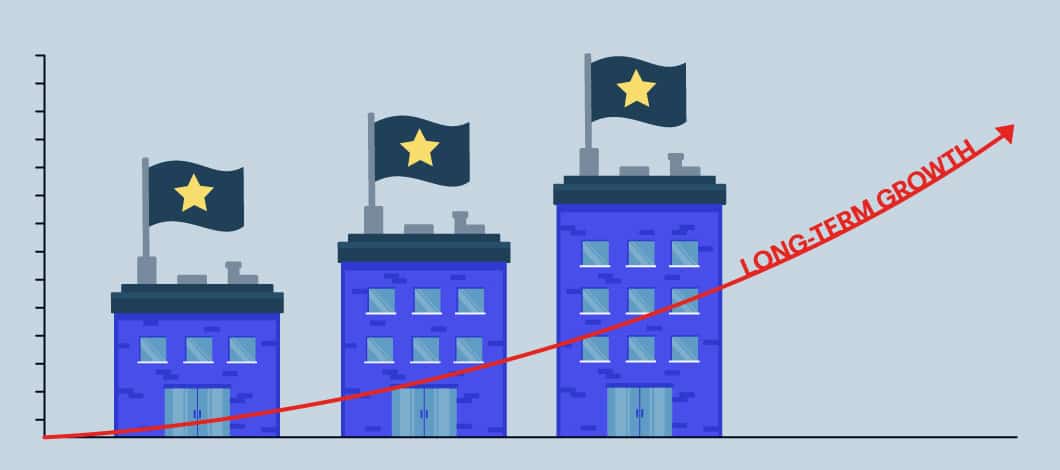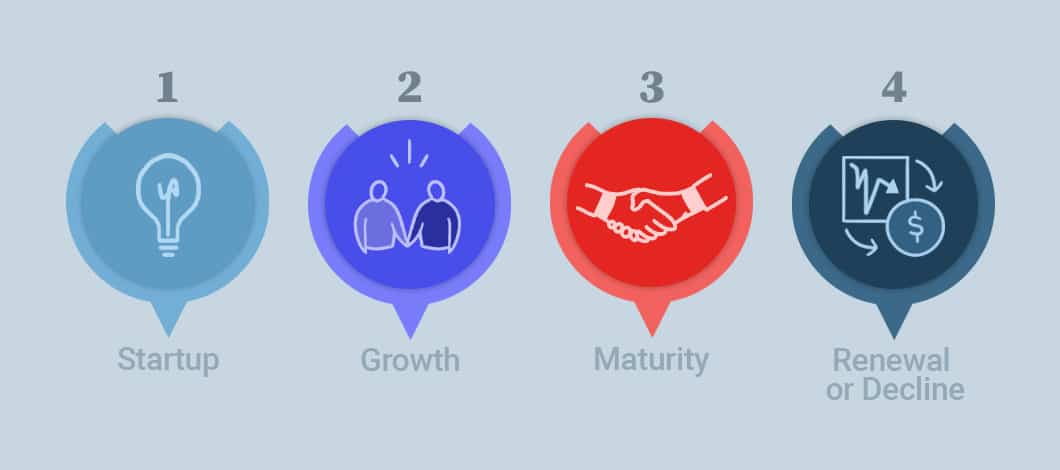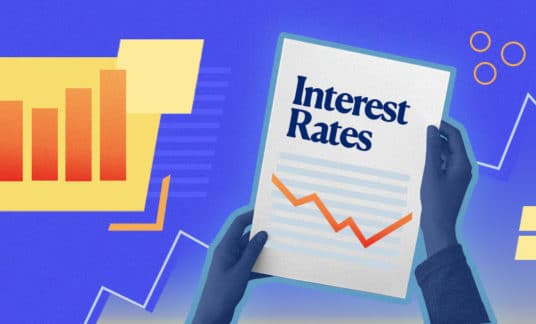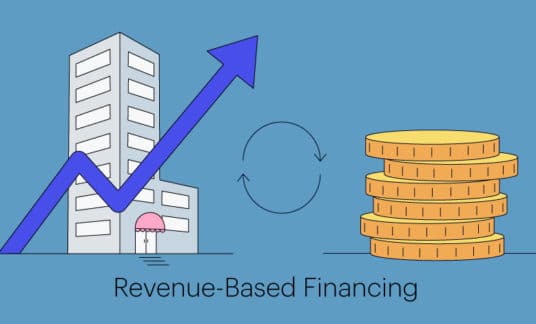Much like living, breathing beings, businesses develop and evolve through a life cycle marked by startup, growth, maturity and renewal (or decline). To ensure success, you need to understand which of the 4 stages of business growth your company is in today and where it needs to be.
1. Startup Phase
Every business begins as an idea. Then, from the moment it’s created, it becomes a startup. This constitutes the first phase of the company growth stages, one which some businesses find themselves occupying for years. During this stage, your main priority is to find and obtain customers, develop a product or service and build a brand identity.
If you’re wondering if your business is in the startup stages of business growth, consider whether you find yourself regularly asking these questions:
- Can we secure enough customers to become viable?
- Can we deliver our product(s) on time?
- How can we expand our sales base?
- Can our services compete with our competitors’?
- Can we secure enough cash to cover our accounts payable?
Business owners who regularly ask themselves any of these questions are more than likely in the startup phase. At this point of the business growth process, the overarching strategy is to simply stay alive, all the while preparing and planning for breaking into the next stage.
As you might expect, this stage is a risky and chaotic one, marked by turbulence and, often, self-doubt. However, of all the stages of business development, the startup phase most requires a confident and headstrong owner to steer the company toward the growth phase.
Breaking Out
The key to success in the breaking-out stage of a company’s life cycle is to take risks, explore new ideas and make adjustments to your business model as needed. Turn what’s been proven to work into standard operating procedures that can be relied on in the future.
This is a critical juncture in many entrepreneurs’ careers since the startup phase is where most businesses fail. In 2020 alone, roughly 18% of private businesses that opened were closed within a year, according to the U.S. Bureau of Labor Statistics.
Don’t let your business become a statistic — have fun with it, test things out and focus on developing formal systems based on what’s worked so far.
2. Growth Phase
Far too often entrepreneurs claim they’re in the growth phase of business simply because they see their sales gradually increasing year after year. However, there is a little more nuance to it than that.
You’ve broken into the growth phase when you (and your customers) know exactly what your business model is. At this point, you should have a refined marketing budget that is comparable to other similarly sized companies in your industry or niche.
Here are telltale signs you’re in the growth phase of business:
- You have increased cash flow
- You have greater borrowing power to finance growth
- You no longer worry about turnover or making payroll
- You’ve maintained multi-year client relationships
- You’re regularly reinvesting profits into the company
- You’ve hired several key high-level team members
During this stage of the business growth process, profits are strong and competition is tight. The pre-eminent challenge associated with the growth stage is maintaining effective management in the face of constant growth and expansion. To break through this stage, you need to develop your managerial skills as you grow your team by learning how to delegate authority and empower your employees.
Constant investment and reinvestment is the name of the game in the growth stage. To continue to scale your business, be willing to dip into cash reserves to spur future growth, tap into new revenue streams or secure external investment.
This is a good time to decide whether you should rely on debt or equity financing to fund your operations in the years ahead.
Scaling Successfully
To make it through the growth phase of the company life cycle, you need to formalize all of your workflows and operating systems. Revisit your business plan and adjust it as your business evolves.
Additionally, as your team expands and you make critical hires, one of the keys to business growth is to have standard processes that all team members can easily follow. Develop these accordingly and delineate what they are in a spreadsheet or text document that can be shared with team members via a cloud network.
Need a loan to grow your business?

3. Maturity Phase
The third phase of a company’s development stages is maturity, one of the most important company growth stages. This can be marked by stagnation, predictable revenues, the acquisition of other business entities and multiple product line spinoffs.
Mature businesses are also prime for investors to buy because they are consistent performers that can reliably generate revenues into the future.
For this reason, if you’re successful enough to grow a business to the maturity phase, you’ll need to consider whether it’s in your best interest to turn to an external investor or continue expanding the company.
Your primary objective during the maturity phase is to ensure that you don’t start nosediving toward decline and, if you do, take action immediately to course-correct. You may develop new products, enter a new market or merge with another company.
4. Renewal or Decline Phase
The standard 4 stages of a business life cycle include a renewal or decline phase, in which the company can renew itself to adapt with the changing times or decline.
Some of the warning signs that a business may be declining include:
- Client payments are frequently late
- Employee turnover is high
- You’ve branched out from the business’s core
- Criticism, disrespect and blame have increased
- Aspirations have diminished and initiative has declined
Sometimes, the final business stages of growth aren’t a reflection of the business owner or the employees. In certain cases, a changing economic landscape, new competitors or adverse market conditions can steer a company toward irrelevance.
At this turning point in the life cycle of a business, it’s critical that the leadership of the company adopt new policies, standard operating procedures and formal systems to suit their changing environment. They may need to upgrade technology, pursue new opportunities or boost their competitive edge.
Much like how successful evolutionary species develop better adaptations in the face of adversity, businesses have to stave off competition by constantly improving functions over time.
Think of some of the most famed American companies that folded: Blockbuster, Woolworth’s and Kodak. Each of these companies failed to make the critical changes necessary for survival that their competitors did. These once-great businesses serve as a reminder that no business is too big to fail — constant growth and renewal are needed to fend off decline.
A company’s success is ultimately determined in this stage of business development. During this phase, leadership must constantly be searching for new growth opportunities and new markets to break into. If necessary, costs need to be cut and budgets must be tightened to sustain cash flow. How a business chooses to adapt will determine whether it becomes a thriving enterprise or a failed venture.

Positioning Your Business for Success
No matter where your company finds itself in its life cycle, you must always set your sights on strategies to ensure long-term business growth. The moment a business becomes too comfortable, it stops searching for new ways to create value. Over time, this can spell disaster.
The key to prolonged entrepreneurial success is to maintain the growth phase business mindset characteristic of entrepreneurs in the early stages of their life cycle. This way, innovation, positivity and experimentation can help you embrace challenges as they arise and move forward toward a permanent state of business maturity.











